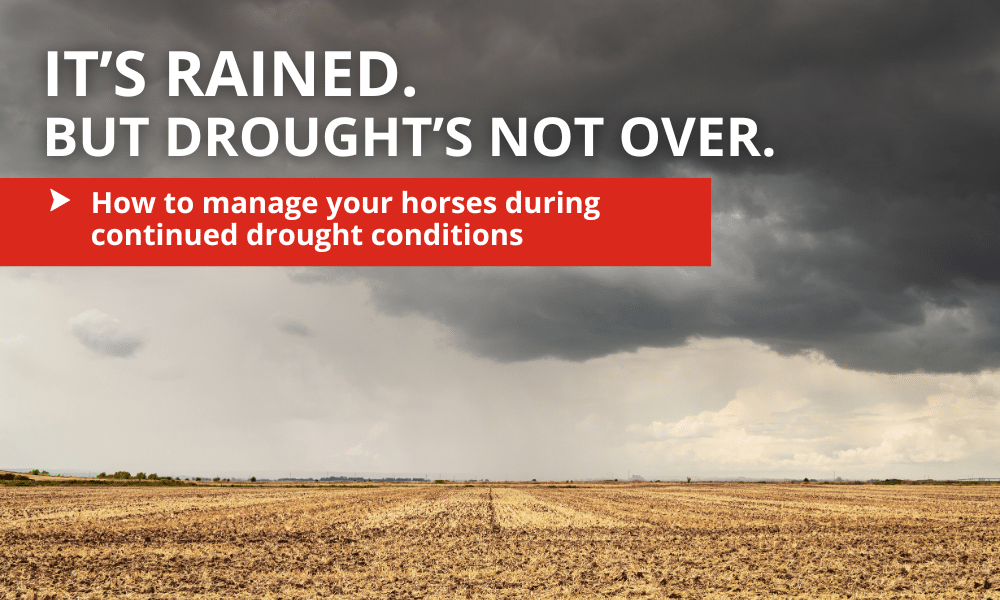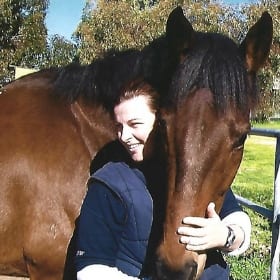
06 Jun Feeding Horses During Drought
It’s been a lovely change to finally get a little rain, but the last 12 months has been incredibly dry. In fact, 2023 had one of the driest winter rainfall periods in living memory, followed by a hot, dry summer and autumn which didn’t help.
This has put WA into a ‘mini drought’ which has had a big impact on agriculture here in WA, and the flow on effects are being felt by horse owners around the state.
For horse owners, drought doesn’t just impact the amount of grass in our paddocks, it impacts the availability, quality and price of the hay and feeds that we can offer our four-legged friends.
Unfortunately, a bit of rain now doesn’t mean that drought will turn off like a switch either, or that we can return to normal. Why?
- Hay shortages (especially pasture hays) will continue for a while yet
- Chaff may be in short supply
- Pastures that have been drought impacted, will take time to come back, and could be damaged if overgrazed too quickly
- Pastures that are receiving fresh growth under stressed conditions can be risky for some horses and ponies
But when fibre is the most important component of your horse’s diet, and they’re digestive system is designed to eat consistently, how can we keep them healthy?
Our team has put together some tips on managing hay and pastures to keep your horses healthy during tough times. You can download this guide by clicking the button below:
key points for managing hay shortages:
Make any changes slowly, ideally over 14-21 days to avoid digestive upsets:
If you find yourself needing to change to a different hay type, try to forward plan as much as possible, so you can introduce the new hay type slowly while still feeding the hay they have been on. Any sudden changes can increase the risk of gastric upsets like colic dramatically.
Make sure the hay has been tested and is safe for feeding:
Hay should come with an ARGT certificate from the WA Department of Agriculture. Meadow hay is not the only hay susceptible; any hay can have ARGT.
Watch out for changes of behaviour in your horses:
Some of the Teff, Rhodes and Lucerne Hays grown in WA can alter the biome of the horse, causing it to become more alkaline causing ALKALOSIS. This can cause an increase in spooky or jumpy behaviour.
- You can do a pH test on your horse’s fresh poo (within 30 seconds of it being deposited) to check for alkalosis. The ideal range should be between pH 6.8-7.
Changing onto or including cereal hays can also impact behaviour, as they are higher in starches and sugars leading to increased energy supply. You may need to balance out the energy in other parts of their diet where this hay is your only option.
Hay quality and feeding straw to horses:
Hay is usually classed as high quality or low quality and the quality refers to the nutritional value, but also the digestibility. ADF (Acid Detergent Fibre) and NDF (Neutral Detergent Fibre) are measures of the fibre components in the hay and indicate the digestibility and energy availability of hay.
Using Low Quality Hay – Low quality hays can still be beneficial for horses that need lower amounts of energy as it still provides a necessary source of long-stem fibres for digestive health without excessive calories.
- High NDF can increase the risk of impaction colic, so NDF should be under 60% for horses prone to colic.
Using Straw – straw can be used to replace a portion of the hay in your horse’s diet to help extend hay supply. You can use straw for up to 20% of their daily fibre/forage intake but they must still be getting the correct protein, vitamins and minerals needed to meet their daily needs. Make sure straw has been ARGT tested.
If using straw, remember:
- Straw must not be fed to foals, weanlings or yearlings as their digestive system is not mature enough to digest it properly.
- Straw is not laminitis friendly. The average straw NSC is over 17%, as most straws come from cereal crops.
- High NDF forage isn’t ideal for horses that are ulcer prone. There has been some research to suggest that it can increase the risk of glandular ulcers. Consult your vet before introducing straw if you are concerned.
- If you need to feed higher than 20% straw, consult with your vet first to make sure that your horse is a candidate for this level of straw.
- The maximum amount of straw per day that can be feed is 50% of the horse’s daily intake.
As hay changes, re-balance the rest of your horse’s diet:
There are a number of reasons why rebalancing is important, not just because of the varying energy and protein levels of different hays:
- Without access to pastures, they may need more fat-soluble vitamins and omega-3.
- When feeding certain hays (like Teff), you will need to supplement to protect against oxalates and prevent bighead disease. Talk to a nutritionist about the right supplementation program for your horse.
- The starch and sugar content of hay can be high, so may need to be balanced in other areas of the diet.
- Please note that Teff isn’t always low in sugar and starch and safe for laminitis/metabolic prone horses and ponies.
- If feeding straw, the protein in other areas of their diet may need to be boosted.
How could lupin fibre cubes help?

If your pasture is starting to grow again, remember:
Reintroduce pasture slowly!
Pasture should be treated in the same way as hay and feed, and re-introduced slowly if your horse or pony has had restricted access.
Watch out for sand burden:
When pasture is eaten down close to the soil, or they are picking up hay and feed off the ground, they are more likely to pick up sand and soil. Talk to your vet if you are worried, before starting any method of sand removal.
Be aware of the starch and sugars in growing pastures:
Ask for help!
If you are not sure what to do, which hay to try or how to manage your horses through this tough period, please reach out to our nutrition team, your vet or a qualified equine nutritionist for help.
The information in this article has been compiled by the team at Thompson & Redwood with Jill Davies from Feed Your Steed Equine Nutrition.

Jill Davies is an Equine Nutritionist who has been involved with horses all her life. Having managed and ridden for an international eventing yard in the USA she then completed her Bachelor in Equine Science from the University of Lincoln. While studying at Curtin University Masters by Research (MSc) research was on use of Proanthocyanidins for gastric health in the competition horse.
Jill taught Equine Nutrition & Equine Exercise Physiology at Curtin University for over seven years and was a sessional lecturer for the Animal & Veterinary Sciences at Murdoch University. Jill now operates her own independent equine nutrition business, Feed Your Steed, operating out of the Lower Southwest of WA.



No Comments